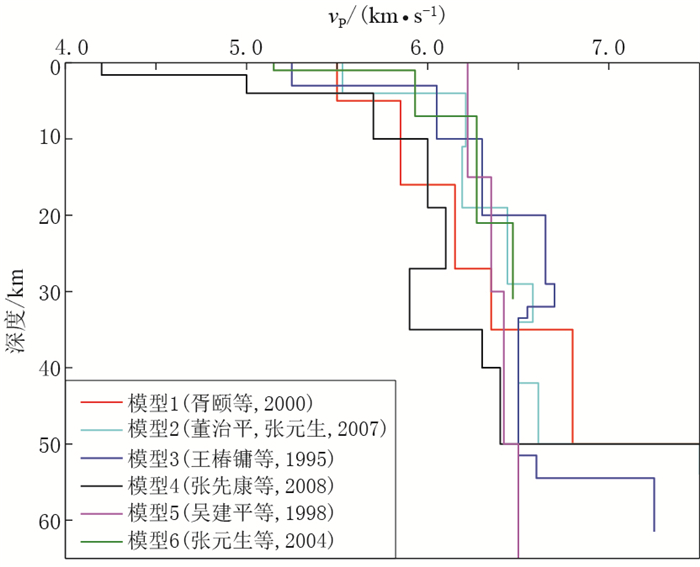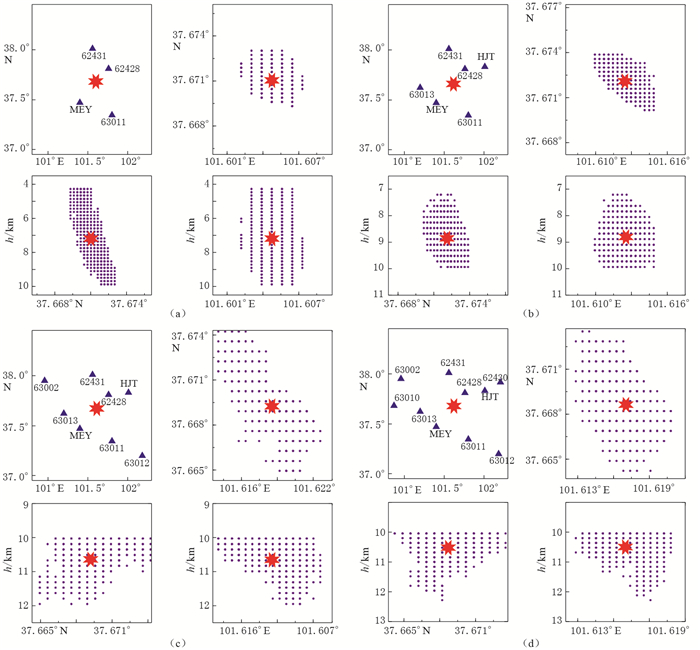Relocation of the 2016 MS6.4 Menyuan, Qinghai earthquake
-
摘要: 利用中国地震科学台阵探测项目中部分台站和青海、甘肃地震台网的观测资料,选取最佳速度模型,利用逆时成像技术对2016年1月21日青海门源MS6.4地震的起始破裂点和震源中心进行成像分析.结果表明:门源地震的发震时刻为北京时间2016年1月21日1时13分11 s,起始破裂点位于 (37.67°N,101.61°E),震源深度为9.41 km;震源中心的位置变迁可以分为1—6 s和7—10 s两个阶段,且均基本位于倾角约75°、倾向NE的斜面附近.根据震源中心的迁移特征,推测走向为335°,倾角为56°,滑动角为97°的节面为门源地震的破裂面.结合该地震滑动角较大及高倾角逆冲构造的活动特征,认为门源MS6.4地震应为冷龙岭北侧高倾角次级逆断层活动的结果.Abstract: The rupture initiation point and hypocentoid of Menyuan MS6.4 earthquake, which occurred on January 21, 2016, were imaged out by means of time-reversal imaging technique (TRIT) using velocity models and waveforms from regional seismic network and China Seismic Array. The results show that, origin time of Menyuan MS6.4 earthquake was 01:13:11 on January 21, 2016 and rupture initiation point was at (37.67°N, 101.61°E), and the focal depth was 9.41 km. The migration of hypocentroid can be divided into two stages of 1--6 s and 7--10 s, which basically located at an inclined plane dipping to NE with an inclination about 75°. According to the characteristic of hypocentroid migration, we speculate that the nodal plane with strike of 335°, dip of 56° and rake of 97° is the rupture plane of Menyuan earthquake. Considering large rake angle, Menyuan earthquake shows characteristic of thrust tectonic activities with high dip angle, so we are likely to convince that Menyuan earthquake resulted from new activity of north Lenglongling secondary thrust fault with high dip angle.
-
引言
地震是一种世界性的自然灾害,而我国又是一个地震灾害严重的国家,每年频发的地震灾害会造成大量的人员伤亡和经济损失。其造成人员伤亡的根本原因是地震动引发的工程结构破坏及其诱发的次生地质灾害,包括滑坡、泥石流、崩塌和落石等。国内外多次地震震后调查和地震监测台站资料(戴嘉伟,2016)均显示地震诱发的斜坡破坏常常出现在凸出、孤立的山脊等地形突变处,具有明显的地形放大效应。将地球表面视作自由面,复杂的地形条件会增加地表自由面的约束,诱导地震波在地形突变处发生动应力集中,进而造成显著的地形效应。因此,开展边坡地震地形放大效应的研究,对于我国的抗震加固设计、地震灾害防治和 “西部大开发” 战略的贯彻落实具有十分重要的理论意义和工程实际应用价值。
在地形地貌变化处(如山峰或峡谷)地震影响系数会显著放大或缩小,此即为地震动的地形放大效应。近年来,对于地震动地形放大效应的研究主要集中在两方面:其一,对地震现场以及模型试验观测数据的研究(Çelebi,1987;李白基等,1999);其二,对数值算法的研究(梁建文等,2012;Poursartip et al,2017)以及对于具有简单几何形状的地形的解析和半解析解研究(高玉峰,2019),如三角楔形体或半圆形山谷地形。
关于地震现场观测数据的研究主要有:Boore (1972)报道了1971年圣费尔南多山谷的地震动情况;Çelebi (1987)研究了1985年智利大地震的地形放大效应;Massa等(2004)分析了2002年意大利莫利塞地震的场地放大现象。上述研究结果表明,建筑结构的损坏主要发生于山脊及软土地带,而且结构的损坏模式与因地表不规则性而引起的与地震频率相关的放大效应有关。此外,Çelebi (1991)收集并总结了三次地震的现场实测结果,为一系列不同频率下的地震引起的地表放大现象提供了佐证。
地形效应的解析解和半解析解方面的研究,主要聚焦于地震动的传播与媒介之间的相互影响关系。地震动传播理论总体可分为积分型和微分型波动传播理论,前者是基于惠更斯、菲涅尔和基尔霍夫积分等定理建立的一套理论体系,而后者则是基于连续介质微分体积元弹性动力学等原理建立起来的一套理论体系,二者在本质上具有一致性。Sills (1978)提出了一种解决均匀半无限空间中任意地形SH波散射问题的积分方程,Sánchez-Sesma等(1982)提出了一种任何不规则地形下SH波散射问题的边界积分法,随后Sánchez-Sesma (1985)又提出了另一种用于求解无限楔形山峰(山谷)的解析法。Trifunac (2010)提出了一种用于求解半圆柱状山谷中SH波衍射问题的封闭解,计算结果显示出显著的放大效应。
常用的数值方法包括域方法和边界方法两种类型。域方法包括有限差分法(Zhang et al,2012)、有限元法(Smith,1975)和谱单元法(Wang et al,2018),该方法的优势在于对介质材料的精细模拟,但在模拟中需要施加人工边界,以便将半空间问题限制在一个有限的区域内求解。Fukushima等(2013)运用动力弹塑性有限元方法模拟了考虑应变软化特征下边坡遭受地震荷载时的应力应变关系;Lin和Huang (2017)运用有限差分软件FLAC模拟地震动作用下边坡滑移体的滑移过程,并分析了其可能的影响区域。另一方面,边界方法可以轻松满足辐射条件并降低研究维度,例如:Bouchon (1973)应用离散波数法研究了凸起地形和凹陷地形对地震动的放大效应,Wong和Jennings (1975)推导了边界积分方程以研究帕克伊马(Pacoima)河谷的两个理想断面在SH波沿任意角度入射情况下的放大效应,Sánchez-Sesma和Rosenblueth (1979)提出了可用于任意形状二维河谷地形的非直接边界积分方程法。上述这些直接或非直接边界积分方程法(边界元法)均需要计算格林函数,但是对于半平面问题而言其计算效率相对较低。
以往的研究主要集中在楔形地形、经典的半圆形河谷和半椭圆形河谷等地形。对于工程中常见的单体边坡模型,国内外也有一些研究成果。刘汉龙等(2003)提出了用最小平均安全系数作为评价指标来反映安全系数随地震动变化的过程;郑颖人等(2009)通过有限差分软件FLAC采用动力强度折减法对地震边坡的破坏机制进行了数值分析,结果表明地震边坡的破坏由边坡潜在破裂区上部的拉破坏与下部的剪切破坏共同组成;Erzin和Cetin (2012)运用人工神经网络和多元线性回归的方法分析了一种典型人工边坡在地震荷载作用下的临界安全系数变化;刘新荣等(2019)结合振动台试验与理论分析方法,对水平层状岩质边坡在反复地震动作用下的累积损伤和破坏模式进行了深入研究。然而,前述研究通过数值模拟和振动台试验等方法,仅对边坡在地震动作用下的破坏形式进行了分析,并未深入揭示地震灾害的成因;事实上,边坡地形效应的存在,会使得地震波在地形突变处产生反射、叠加、衍射,进而影响地震动的幅度。
为此,本文拟采用动力有限单元法对单体边坡地形的地震响应及其放大规律进行参数分析,以期厘清不同的坡角和坡高对地形放大效应的影响。将位移峰值放大系数(peak displacement amplification factor,缩写为PDA)作为衡量地震动放大效应的标准,分析模型关键监测点的输出波形及其放大系数的变化趋势,以探究不同地形条件下地震动的放大效应,以期对地震动所产生的工程破坏预测以及建筑结构的抗震设计提供参考。
1. 数值模型的建立
1.1 分析模型
岩质边坡的模型如图1所示,模型坡高H为100 m,坡顶宽度为50 m。为研究边坡地形对地震动放大效应的影响,设置计算工况如下:保持边坡高度100 m不变,边坡角度分别取30°,45°,60°,75°;保持边坡角度30°不变,边坡高度分别取70,80,90,100 m。
大型工程的抗震分析需要考虑地震波的辐射阻尼效应,目前的研究常采用截取近场有限域并在其边界处施加人工虚拟边界的方法来解决此问题。张伯艳和李德玉(2014)采用黏弹性边界为吸能边界,以体现无限地基辐射阻尼的影响,并基于此对白鹤滩水电站左岸的岩质边坡进行了分析计算;陈宝魁等(2016)介绍了黏弹性人工边界在结构-地基动力相互作用等问题中的应用现状研究,重点叙述了黏弹性人工边界在有限元计算中的实现方法及其在地震工程中的应用;蒋锋云等(2018)采用黏弹性人工边界构建了川滇地区地壳三维黏弹性有限元模型,深入分析了汶川地震对川滇地区的震后影响。本文选用刘晶波等(2006)提出的等效二维一致黏弹性边界,即在模型边界处设置相应的弹簧和阻尼器(图2),当弹性地震动传播至模型边界时,弹性波的绝大部分能量均会被弹簧和阻尼器吸收,即经过处理后的模型边界可近似等效为无限边界。二维黏弹性人工边界等效物理系统的弹簧刚度和阻尼系数分别为:
切向边界:
${K_{\rm BT}} {\text{=}} {\alpha _{\rm T}} \cdot \frac{G}{R} {\text{,}}$


(1) ${C_{\rm BT}} {\text{=}} \rho \cdot {v_{\rm S}}{\text{,}}$


(2) 法向边界:
${K_{\rm BN}} {\text{=}} {\alpha _{\rm N}} \cdot \frac{G}{R}{\text{,}}$


(3) ${C_{\rm BN}} {\text{=}} \rho \cdot {v_{\rm P}}{\text{,}}$


(4) $G {\text{=}} \frac{E}{{2\!\!\!\!{\text{(}}\!1 {\text{+}} \mu\!{\text{)}}\!\!\!\!}}{\text{,}}$


(5) This page contains the following errors:
error on line 1 at column 1: Start tag expected, '<' not foundBelow is a rendering of the page up to the first error.
${v_{\rm P}} {\text{=}} \sqrt {\frac{{E\!\!\!\!{\text{(}}\!1{\text{-}}\mu\!{\text{)}}\!\!\!\!}}{{\rho \!\!\!\!{\text{(}}\!1 {\text{+}} \mu\!{\text{)}}\!\!\!\!\!\!\!\!{\text{(}}\!1{\text{-}}2\mu\!{\text{)}}\!\!\!\!}}}{\text{,}} $


(6) ${v_{\rm S}} {\text{=}} \sqrt {\frac{E}{{2\rho \!\!\!\!{\text{(}}\!1 {\text{+}} \mu\!{\text{)}}\!\!\!\!}}}{\text{;}}$


(7) This page contains the following errors:
error on line 1 at column 9: Extra content at the end of the documentBelow is a rendering of the page up to the first error.
E本文采用三节点三角形平面应变单元对计算区域进行离散,网格尺寸的大小直接影响计算精度和速度,但由于本文数值模型均为二维模型,相对而言对计算耗时的要求不及三维模型严格,再加上本文着重考虑确保模拟地震动的精度,因此本文选取的网格尺寸控制在最短波长。采用线弹性本构模型,其材料参数列于表1.
表 1 本文模型的材料参数Table 1. Material parameters of the model in this study材料 密度/(kg·m−3) 弹性模量/GPa 泊松比 岩体 2 400 50 0.25 节理 2 320 5 0.30 1.2 地震动输入
本文数值模型采用雷克子波模拟地震动输入,以位移荷载的形式施加于模型底部,以模拟垂直入射的平面地震动。雷克子波的表达式如下:
$F\!\!\!\!{\text{(}}\!t\!{\text{)}}\!\!\!\! {\text{=}} A[1{\text{-}}2{\pi ^2}{f^2}{\!\!\!\!{\text{(}}\!t{\text{-}}{t_0}\!{\text{)}}\!\!\!\!^2}]\exp[ { {{\text{-}}{\pi ^2}{f^2}{{\!\!\!\!{\text{(}}\!t{\text{-}}{t_0}\!{\text{)}}\!\!\!\!}^2}} } ]{\text{,}}$


(8) 式中,A为地震动最大振幅,f为波形中心频率,本文取f =10 Hz。雷克子波在频域的波形如图3所示,可见地震动持时为0.2 s,峰值加速度为1.5 m/s2。本文在模型底部同时施加水平和竖直方向的入射波。Chang等(2015)为更好地表征不同模型尺寸的影响,建议采用无量纲频率η来描述。
$\eta {\text{=}}\frac{{{{2{H}}}}}{\lambda } {\text{=}} \frac{{2Hf}}{c}{\text{,}}$


(9) 式中,H为坡高,f为波形中心频率,c为波速。根据本文数据可计算出当坡高分别为70,80,90,100 m时,对应的无量纲频率η分别为0.28,0.32,0.36,0.40。
对于显式算法,为了满足计算收敛和算法稳定性,需满足最小时间积分步长的限制;而对于本文采用的隐式算法,时间步长取为输入时程的离散时间步距即可,这对频带和计算精度均无影响。本文取f =10 Hz,采样时间间隔为0.000 1 s。
2. 单体边坡的地震动响应规律
2.1 关键点波形输出
张泽林等(2018)和詹志发等(2019)均在其边坡模型振动台试验中采取在关键点设置传感器的方法来记录相关试验数据,进而分析边坡的动力响应规律;丁梓涵等(2015)利用FLAC3D软件模拟了地震动作用下不同岩层倾角的顺倾向边坡,从坡脚起沿顺坡面而上,每隔2 m设置一个监测点,探讨了岩层倾角对顺倾边坡所产生的地震效应的影响;冯永等(2017)运用ABAQUS软件建立了三维模型,并在边坡关键位置设置监测点来监测其应力应变的变化情况,进一步探讨了地震动作用下的桩土作用机理。本文选取的监测点及其标号如图2所示,监测点7的地震动波形如图4所示。
对不同工况(边坡角度、边坡高度)下的计算结果,选取入射监测点、沿坡面向上的三个监测点(1,2,3)的位移输出结果进行分析,结果如图5所示,可见:不同监测点的波形呈现出相似性,且随着监测点高度的增加(监测点1→2→3),坡体位移峰值出现的时间呈现滞后效应,表明位置越高的监测点,位移峰值出现的时间越靠后,这与地震动的传播方向吻合。本文施加的地震动作用在模型底部,沿单体边坡向上传播,因此峰值位移的出现时间呈现滞后效应。此外,不同坡角条件下,位移峰值的出现呈现出相似的先后顺序,即沿坡面向上位移峰值呈现递增趋势(监测点1→2→3),最大峰值位移出现在坡顶监测点3处。
2.2 地震动放大系数
为了更好地对地震动放大效应进行分析,本文引入位移峰值放大系数这一概念来对单体边坡模型的放大效应进行定量分析。定义位移峰值放大系数(PDA)为
${\rm P}{\rm{D}}{A_i} {\text{=}} \frac{{U_i^{\max }}}{{{U_0}}}{\text{,}}$


(10) This page contains the following errors:
error on line 1 at column 1: Start tag expected, '<' not foundBelow is a rendering of the page up to the first error.
2.3 边坡中地震动放大效应的影响
在实际的隧道工程中,不同高程隧道洞口的存在改变了山体边坡表面及内部的场地条件,从而对坡面的稳定性产生影响,同样也会影响到山体边坡整体的地震响应。李天斌(2008)分析了汶川大地震造成位于震中附近的都江堰—汶川公路多座隧道严重受损的情况;王猛等(2019)设计了高陡黄土边坡大型振动台模型试验并分析了坡面不同高程以及隧道的存在对整体边坡地震动放大效应的影响;孙强强等(2019)利用数值方法研究了均匀弹性场地中圆形隧道对地表水平向峰值加速度的影响,分析了不同隧道埋深和不同入射波频率下地表水平向加速度的变化规律。因此,本文的分析中除考虑坡面地震动特征之外,也考虑了与坡面等高程处边坡内部监测点的地震动响应,并结合计算结果对其进行分析。为便于观察,本文对模型计算数据进行后处理,提取不同条件下相应关键监测点的位移峰值放大系数,结果如图6和图7所示。
从图6a可以看出:不同边坡角度α下,水平向位移放大系数的最大值均出现在边坡顶部监测点3,水平向位移峰值放大系数分别为2.36 (坡角α=30°),2.1 (α=45°),2.06 (α=60°),1.84 (α=75°);在坡顶同一高度处的位移峰值放大系数与坡顶监测点3相比略小,且随着坡角的增大,水平向位移峰值放大系数呈递减趋势;在相同高度处,坡面监测点的位移峰值放大系数略大于坡内监测点(监测点 1>6,2>5,3>4),说明水平向位移峰值放大系数的分布呈现出一定的趋表效应。从图6b可以看出:坡角α=45°,60°,75°时,竖直向位移峰值放大系数的最大值同样出现在边坡顶部监测点3,其值分别为3.16 (坡角α=45°),3.19 (α=60°),3.31 (α=75°);当坡角α为30°时,竖直向位移峰值放大系数的最大值反而出现在坡内监测点5,其值为3.65,究其原因是在坡度较缓的情况下(α=30°),入射的竖向波在坡面产生了一定程度的反射波,反射波与入射波在坡内叠加,进而造成了竖直向位移峰值放大系数最大值出现在坡体内部。从图6c可以看出:总位移峰值放大系数的分布与竖直向位移峰值放大系数的分布大致相似,沿坡面向上的监测点的位移峰值放大系数呈现递增趋势(监测点1→2→3);除坡角为30°时,其余坡角的总位移峰值放大系数均出现在坡顶监测点3处,其值分别为2.53 (α=45°),2.61 (α=60°)和2.65 (α=75°);当坡角为30°时,其总位移峰值放大系数为2.62,最大值出现在坡内监测点5处,这是由于竖直向位移峰值放大系数的数值大于水平向位移峰值放大系数,因此合成之后的位移最大值出现在监测点5处。
从图7a可以看出:随着边坡角的增大,监测点2,3,4和5的水平向位移峰值放大系数呈减小趋势;监测点1和6的水平向位移峰值放大系数呈增大趋势,水平向位移峰值放大系数的最大值出现在坡顶监测点3和4处。由图7b可以看出:随着边坡角的增大,坡顶监测点3的竖直向位移峰值放大系数变化不大,其值在3.2—3.3之间波动;监测点2亦是如此,其值在2.9—3.1之间上下波动,变化幅度不大;随着边坡角的增大,监测点1,4,5和6的竖直向位移峰值放大系数均呈减小趋势。图7c的总位移放大规律与竖直向位移放大规律类似,即:随着边坡角度的增大,监测点1,4,5和6的总位移峰值放大系数呈减小趋势,坡顶监测点3的总位移峰值放大系数则呈增大趋势,坡面中部监测点2则上下波动,变化不明显。
为全面揭示坡形影响,沿着监测点4→3→2→1的方向,即沿着从左往右的方向,适当加密监测点,每个监测点附近选取5个加密点,共计20个监测点。编制相关程序提取不同计算工况下的最大水平向、竖直向以及总位移值并计算相应的放大系数,结果如图8所示。
值得注意的是,图8中横坐标监测点序数是按照监测点4→3→2→1的顺序进行加密,即由坡顶沿坡面向下排列,可以看出:不同坡角工况下,位移放大系数的变化趋势与前述分析基本吻合。
图9和图10分别给出了不同高度单体边坡关键点的位移放大系数的变化情况。从图9a可以看出:水平向位移峰值放大系数出现在坡顶监测点3处,且最大值出现在η=0.40时,其值分别为2.096 (η=0.28),2.095 (η=0.32),2.10 (η=0.36)和2.36 (η=0.40);同一高度的水平向位移峰值放大系数呈现出一定的趋表效应,即同一高度下坡面监测点(监测点1,2和3)的水平向位移峰值放大系数略大于坡内监测点(监测点6,5和4)。由图9b和图9c可知,竖直向位移峰值放大系数与总位移峰值放大系数呈现大致相同的波动状况,这是由于竖直向位移峰值放大系数大于水平向位移峰值放大系数,因此合成之后占主导地位,使得总位移峰值放大系数与竖直向位移峰值放大系数的波动状况相似,在η分别为0.28,0.32,0.36,0.40时均沿着坡面向上的监测点(监测点1,2和3)呈递增趋势。
由图10可以看出:随着边坡高度的增大,坡顶监测点3和4的水平向位移峰值放大系数随之增大,而其余监测点的水平向位移峰值放大系数则呈下降趋势(图10a);对于竖直向位移峰值放大系数而言,所有监测点几乎都呈现随高度增加而减小的趋势(图10b),且各监测点竖直向位移峰值放大系数大于水平向位移峰值放大系数,因此总位移放大系数中竖直向位移峰值放大系数占主导地位,其波动规律与竖直向位移峰值放大系数类似(图10c)。
为全面揭示坡形影响,沿着监测点4→3→2→1的方向,适当加密监测点,每个监测点附近选取5个加密点,共计20个监测点,编制相关程序提取不同坡高情况下其最大水平向、竖直向以及总位移,并计算相应的放大系数,结果如图11所示。
与图8类似,横坐标按照监测点4→3→2→1的顺序进行加密,即由坡顶沿坡面向下排列,可以看出,不同坡高工况下位移峰值放大系数的变化趋势与前述分析基本一致。
3. 讨论与结论
本文采用动力有限单元法,分析了单体边坡的地震动力响应规律,研究了不同边坡角度、边坡高度工况下单体边坡的地形放大效应,根据计算结果,得出以下结论:
1) 不同监测点的波形表现出相似性,即:随着监测点高度的增加,坡体位移峰值出现时间呈现滞后效应,这与地震动的传播方向吻合;不同坡角条件下位移峰值的出现呈现相似的先后顺序,即沿坡面向上位移峰值呈现递增趋势,最大峰值位移出现在坡顶监测点3处。
2) 当坡角为30°时,竖直向位移峰值放大系数和总位移峰值放大系数的最大值出现在坡内监测点5,原因是在坡度较缓的情况下,入射的竖向波在坡面产生了一定程度的反射,反射波与入射波在坡内叠加,造成了竖直向位移峰值放大系数的最大值出现在坡体内部。监测点2,3,4和5的水平向位移峰值放大系数随坡角的增大均呈现减小的趋势,坡脚监测点1和6随着坡角增大呈递增趋势,水平向位移峰值放大系数的最大值出现在坡顶监测点3处。坡顶监测点3的水平向位移峰值放大系数随坡角的增大变化不大,在3.2—3.3之间波动,监测点2的值在2.9—3.1之间上下波动,监测点1,4,5和6的值随着坡角增大均呈现减小趋势。相同高度处,坡面监测点的位移峰值放大系数略大于坡内监测点,可见水平向位移峰值放大系数的分布呈现一定的趋表效应。
3) 在不同坡高的条件下,水平向位移峰值放大系数最大值出现在坡顶监测点3处,且最大值出现在η=0.4时,同一高度的水平向位移峰值放大系数呈现一定的趋表效应,即同一高度时坡表面的水平向位移峰值放大系数大于坡体内部的水平向位移峰值放大系数。竖直向位移峰值放大系数与总位移峰值放大系数呈现出大致的波动状况,在η分别为0.28,0.32,0.36,0.40 (坡高为70,80,90,100 m)时均沿着坡面向上的监测点呈递增趋势。随着边坡高度的增大,坡顶监测点3和4的水平向位移峰值放大系数也随着增大,其余监测点的水平向位移峰值放大系数则随高度增大呈下降趋势。对于竖直向位移峰值放大系数而言,几乎所有监测点都呈现随高度增加而减小的趋势,且各监测点的竖直向位移峰值放大系数大于水平向位移峰值放大系数,其波动规律与竖直向位移峰值放大系数类似。
-
图 6 基于模型4利用4—10个台站的观测资料确定的震中 (a)、震源深度 (b) 和发震时刻 (c) 的不确定性绝对值ξ λφc,ξ hc和τ0 c
Figure 6. Uncertainties in absolute value ξ λφc, ξ hc, τ 0c of epicenter (a), focal depth (b) and origin time (c) determined by the observation data from 4-10 stations, respectively, basing on the model style="class:table_top_border2"
图 7 使用不同数量台站组合确定的门源MS6.4地震的震源位置及其模糊度
(a) 4个台站;(b) 6个台站;(c) 8个台站;(d) 10个台站.每个子图中,左上为台站与震中的分布,右上、左下和右下分别为震源及其模糊度在水平面、深度-纬度平面和深度-经度平面的投影
Figure 7. Source locations and ambiguities determined by different number of stations
(a), (b), (c) and (d) are from 4, 6, 8 and 10 stations, respectively. In each subplot, the upper-left one shows stations and epicenter, the upper-right, lower-left and lower-right ones are projection of the focus and its ambiguity on ground surface, depth-latitude cross-section, and depth-longitude cross-section, respectively
图 8 门源地震震源中心沿水平方向 (a) 和1—6 s破裂深度 (b) 及7—10 s破裂深度 (c) 的分布
色标表示震源中心出现时间距门源地震发生的时间差,剖面AA′为震源中心的优势方向
Figure 8. Distribution of hypocentroid along horizontal (a), rupture depth of 1-6 s (b) and 7-10 s (c)
The color bar represents the elapsed time from Menyuan earthquake to the time of hypocentroid. Profile AA′ indicates the predominant direction of hypocentroid
表 1 不同研究机构测定的震源参数
Table 1 Source parameters determined by different institutes
资料来源 发震时刻 φN/° λE/° h/km 年-月-日 时:分:秒 中国地震台网中心 2016-01-21 01:13:12.00 37.66 101.65 10 青海省地震台网 2016-01-21 01:13:12.65 37.65 101.61 10 甘肃省地震台网 2016-01-21 01:13:13.09 37.69 101.69 12 USGS 2016-01-21 01:13:13.65 37.67 101.64 9 注:φ为震中纬度,λ为震中经度,h为震源深度,下同. 表 2 本文所选台站及其相距门源MS6.4地震的震中距和方位角
Table 2 Seismic stations selected and their epicentral distances and azimuths of the Menyuan MS6.4 earthquake
台站 震中距/km 方位角/° 62428 19 30 MEY 30 227 HJT 37 59 63011 37 158 62431 39 348 63013 40 264 62430 56 59 63002 69 298 63010 69 272 63012 70 137 表 3 根据不同速度模型确定的震源参数及其不确定性
Table 3 Source parameters and their uncertainties determined using different velocity models
发震时刻 Δt/s φN/° Δφ/° λE/° Δλ/° h/km Δh/km 模型 年-月-日 时:分:秒 2016-01-21 01:13:12.1256 ±0.331 37.66996 ±0.00684 101.61693 ±0.00518 9.433 ±4.215 1 2016-01-21 01:13:12.4875 ±0.124 37.67102 ±0.00873 101.61706 ±0.00916 4.739 ±3.434 2 2016-01-21 01:13:12.4226 ±0.101 37.66912 ±0.00397 101.61710 ±0.00394 4.409 ±3.368 3 2016-01-21 01:13:11.8023 ±0.098 37.66836 ±0.00662 101.61743 ±0.00342 10.468 ±1.812 4 2016-01-21 01:13:12.8178 ±0.128 37.67123 ±0.00930 101.61711 ±0.00864 1.581 ±3.265 5 2016-01-21 01:13:12.4550 ±0.096 37.66863 ±0.00568 101.61679 ±0.00561 4.916 ±2.485 6 注:Δt,Δφ,Δλ和Δh分别为发震时刻、纬度方向、经度方向和震源深度的不确定性, 下同. 表 4 基于模型4利用不同台站组合确定的震源参数及其不确定性
Table 4 Source parameters and their uncertainties based on the model 4 using various station groups
发震时刻 Δt/s φN/° Δφ/° λE/° Δλ/° h/km Δh/km 台站
个数年-月-日 时:分:秒
2016-01-2101:13:11.5763 ±0.104 37.68235 ±0.00386 101.59636 ±0.00971 13.317 ±1.310 4 2016-01-21 01:13:11.7951 ±0.058 37.67199 ±0.00247 101.60572 ±0.00451 10.225 ±1.219 5 2016-01-21 01:13:11.8289 ±0.087 37.67215 ±0.00199 101.61248 ±0.00254 8.822 ±1.613 6 2016-01-21 01:13:11.8099 ±0.073 37.67354 ±0.00292 101.61420 ±0.00315 10.364 ±1.372 7 2016-01-21 01:13:11.7868 ±0.093 37.67203 ±0.00311 101.61428 ±0.00436 9.632 ±1.829 8 2016-01-21 01:13:11.7782 ±0.062 37.67287 ±0.00447 101.61411 ±0.00387 10.405 ±0.717 9 2016-01-21 01:13:11.7996 ±0.098 37.66871 ±0.00481 101.61696 ±0.00412 10.545 ±1.736 10 表 5 用不同窗长的P波确定的震源参数及其不确定性
Table 5 Source parameters and their uncertainties determined by P waves with different window length
发震时刻 Δt/s φN/° Δφ/° λE/° Δλ/° h/km Δh/km L/s 年-月-日 时:分:秒 2016-01-21 01:13:11.7596 ±0.058 37.67232 ±0.00099 101.61479 ±0.00096 9.406 ±0.967 1.0 2016-01-21 01:13:11.8289 ±0.087 37.67215 ±0.00199 101.61248 ±0.00254 8.822 ±1.613 2.0 2016-01-21 01:13:11.9882 ±0.232 37.67116 ±0.00502 101.61408 ±0.00388 8.272 ±4.216 3.0 注:L为P波的窗长,下同. 表 6 用不同窗长L的P波确定的震源中心的参数及其不确定性
Table 6 Hypocentroid parameters and their uncertainties determined by P waves with different window length L
发震时刻 Δt/s φN/° Δφ/° λE/° Δλ/° h/km L/s 年-月-日 时:分:秒 2016-01-21 01:13:11.7596 ±0.058 37.67232 ±0.00099 101.61479 ±0.00096 9.406 1.0 2016-01-21 01:13:11.8441 ±0.133 37.67133 ±0.00225 101.61383 ±0.00268 8.822 2.0 2016-01-21 01:13:11.9882 ±0.232 37.67116 ±0.00502 101.61408 ±0.00388 8.272 3.0 2016-01-21 01:13:11.9317 ±0.235 37.67006 ±0.00675 101.61308 ±0.00773 8.088 4.0 2016-01-21 01:13:11.9204 ±0.208 37.67054 ±0.00599 101.61272 ±0.00863 7.967 5.0 2016-01-21 01:13:12.2306 ±0.171 37.66971 ±0.00561 101.61203 ±0.00753 7.757 6.0 2016-01-21 01:13:12.2427 ±0.236 37.66924 ±0.00622 101.61413 ±0.00757 7.313 7.0 2016-01-21 01:13:12.4561 ±0.272 37.67027 ±0.00714 101.61455 ±0.00864 7.681 8.0 2016-01-21 01:13:12.4553 ±0.332 37.67019 ±0.00801 101.61463 ±0.01131 8.345 9.0 2016-01-21 01:13:12.3842 ±0.475 37.67077 ±0.01110 101.61343 ±0.01249 9.066 10.0 -
董治平, 张元生. 2007.河西走廊中部地区三维速度结构研究[J].地球学报, 28(3): 270-276. http://www.cnki.com.cn/Article/CJFDTOTAL-DQXB200703004.htm Dong Z P, Zhang Y S. 2007. A study of the 3-D velocity structure in central Hexi corridor[J]. Acta Geoscientica Sinica, 28(3): 270-276 (in Chinese).
何文贵, 刘百篪, 袁道阳, 杨明. 2000.冷龙岭活动断裂的滑动速率研究[J].西北地震学报, 22(1): 90-97. http://www.cnki.com.cn/Article/CJFDTOTAL-ZBDZ200001017.htm He W G, Liu B C, Yuan D Y, Yang M. 2000. Research on slip rates of the Lenglongling active fault zone[J]. Northwestern Seismological Journal, 22(1): 90-97 (in Chinese). http://en.cnki.com.cn/Article_en/CJFDTOTAL-DQXB200703004.htm
何文贵, 袁道阳, 葛伟鹏, 罗浩. 2010.祁连山活动断裂带中东段冷龙岭断裂滑动速率的精确厘定[J].地震, 30(1): 131-137. http://www.cnki.com.cn/Article/CJFDTOTAL-DIZN201001014.htm He W G, Yuan D Y, Ge W P, Luo H. 2010. Determination of the slip rate of the Lenglongling fault in the middle and eastern segments of the Qilian mountain active fault zone[J]. Earthquake, 30(1): 131-137 (in Chinese). https://www.researchgate.net/publication/285769593_Determination_of_the_slip_rate_of_the_lenglongling_fault_in_the_middle_and_eastern_segments_of_the_qilian_mountain_active_fault_zone
胡朝忠, 杨攀新, 李智敏, 黄帅堂, 赵妍, 陈丹, 熊仁伟, 陈庆宇. 2016. 2016年1月21日青海门源6.4级地震的发震机制探讨[J].地球物理学报, 59(5): 1637-1646. doi: 10.6038/cjg20160509 Hu C Z, Yang P X, Li Z M, Huang S T, Zhao Y, Chen D, Xiong R W, Chen Q Y. 2016. Seismogenic mechanism of the 21 January 2016 Menyuan, Qinghai MS6.4 earthquake[J]. Chinese Journal of Geophysics, 59(5): 1637-1646 (in Chinese). http://manu39.magtech.com.cn/Geophy_en/CN/Y2016/V59/I3/211
孙蒙, 王卫民, 王洵, 何建坤. 2015. 2013年7月22日甘肃岷县—漳县MS6.6地震震源破裂过程[J].地球物理学报, 58(6): 1909-1918. doi: 10.6038/cjg20150607 Sun M, Wang W M, Wang X, He J K. 2015. Rupture process of the Minxian-Zhangxian, Gansu, China MS6.6 earthquake on 22 July 2013[J]. Chinese Journal of Geophysics, 58(6): 1909-1918 (in Chinese). doi: 10.6038/cjg20150607
王椿镛, 林中洋, 陈学波. 1995.青海门源—福建宁德地学断面综合地球物理研究[J].地球物理学报, 38(5): 590-598. http://www.cnki.com.cn/Article/CJFDTOTAL-DQWX505.004.htm Wang C Y, Lin Z Y, Chen X B. 1995. Comprehensive study of geophysics on geoscience transect from Menyuan, Qinghai Province, to Ningde, Fujian Province, China[J]. Chinese Journal of Geophysics, 38(5): 590-598 (in Chinese). http://manu39.magtech.com.cn/Geophy/EN/abstract/abstract4173.shtml
吴建平, 明跃红, 叶太兰, 曾融生. 1998.体波波形反演对青藏高原上地幔速度结构的研究[J].地球物理学报, 41(增刊): 15-25. http://www.cnki.com.cn/Article/CJFDTOTAL-DQWX1998S1001.htm Wu J P, Ming Y H, Ye T L, Zeng R S. 1998. Upper mantle velocity structure in the Qinghai-Xizang Plateau from inversion of body waveforms[J]. Chinese Journal of Geophysics, 41(Suppl): 15-25 (in Chinese). http://en.cnki.com.cn/Article_en/CJFDTOTAL-DQWX1998S1001.htm
徐纪人, 姚立珣, 汪进. 1986. 1986年8月26日门源6.4级地震及其强余震的震源机制解[J].西北地震学报, 8(4): 82-84. http://www.cnki.com.cn/Article/CJFDTOTAL-ZBDZ198604012.htm Xu J R, Yao L X, Wang J. 1986. Earthquake source mechanisms of Menyuan earthquake (MS=6.4, on Aug. 26, 1986) and its strong aftershocks[J]. Northwestern Seismological Journal, 8(4): 82-84 (in Chinese).
许力生, 杜海林, 严川, 李春来. 2013a.一种确定震源中心的方法:逆时成像技术 (一):原理与数值实验[J].地球物理学报, 56(4): 1190-1206. http://www.cnki.com.cn/Article/CJFDTOTAL-DQWX201304016.htm Xu L S, Du H L, Yan C, Li C L. 2013a. A method for determination of earthquake hypocentroid: Time-reversal imaging technique Ⅰ: Principle and numerical tests[J]. Chinese Journal of Geophysics, 56(4): 1190-1206 (in Chinese). http://manu39.magtech.com.cn/Geophy/EN/abstract/abstract9434.shtml
许力生, 严川, 张旭, 李春来. 2013b.一种确定震源中心的方法:逆时成像技术 (二):基于人工地震的检验[J].地球物理学报, 56(12): 4009-4027. http://www.cnki.com.cn/Article/CJFDTOTAL-DQWX201312007.htm Xu L S, Yan C, Zhang X, Li C L. 2013b. A method for determination of earthquake hypocentroid: Time-reversal imaging technique Ⅱ: An examination based on people-made earthquakes[J]. Chinese Journal of Geophysics, 56(12): 4009-4027 (in Chinese). http://en.cnki.com.cn/Article_en/CJFDTOTAL-DQWX201312007.htm
许力生, 严川, 张旭, 李春来. 2013c.芦山MS7.0地震究竟发生在哪里?[J].地球物理学报, 56(9): 2982-2993. http://manu39.magtech.com.cn/Geophy/CN/abstract/abstract9749.shtml Xu L S, Yan C, Zhang X, Li C L. 2013c. Where did the Lushan MS7.0 earthquake occur in the world?[J]. Chinese Journal of Geophysics, 56(9): 2982-2993 (in Chinese). http://manu39.magtech.com.cn/Geophy/EN/Y2013/V56/I9/2982
徐锡伟. 2016. 2016年1月21日青海门源6. 4级地震发震构造图[EB/OL]. [2016-01-21]. http://www.eq-igl.ac.cn/upload/images/2016/1/2191153838.jpg. Xu X W. 2016. Seismogenic structure of the 21 January 2016 Menyuan, Qinghai 6.4 earthquake. [EB/OL]. [2016-01-21]. http://www.eq-igl.ac.cn/upload/images/2016/1/2191153838.jpg (in Chinese).
胥颐, 刘福田, 刘建华, 孙若昧.何建坤. 2000.中国大陆西北造山带及其毗邻盆地的地震层析成像[J].中国科学: D辑, 30(2): 113-122. http://www.cnki.com.cn/Article/CJFDTOTAL-JDXK200002000.htm Xu Y, Liu F T, Liu J H, Sun R M, He J K. 2000. Seismic tomography of northwest orogenic belt and adjacent basins in Chinese mainland[J]. Science in China: Series D, 30(2): 113-122 (in Chinese).
张先康, 嘉世旭, 赵金仁, 张成科, 杨健, 王夫运, 张建狮, 刘宝峰, 孙国伟, 潘素珍. 2008.西秦岭—东昆仑及邻近地区地壳结构:深地震宽角反射/折射剖面结果[J].地球物理学报, 51(2): 439-450. http://cpfd.cnki.com.cn/Article/CPFDTOTAL-ZGDW200710002411.htm Zhang X K, Jia S X, Zhao J R, Zhang C K, Yang J, Wang F Y, Zhang J S, Liu B F, Sun G W, Pan S Z. 2008. Crustal structures beneath West Qinling-East Kunlun orogen and its adjacent area: Results of wide-angle seismic reflection and refraction experiment[J]. Chinese Journal of Geophysics, 51(2): 439-450 (in Chinese). http://manu39.magtech.com.cn/Geophy/EN/abstract/abstract528.shtml
张勇, 许力生, 陈运泰, 刘瑞丰. 2014. 2014年8月3日云南鲁甸MW6.1 (MS6.5) 地震破裂过程[J].地球物理学报, 57(9): 3052-3059. doi: 10.6038/cjg20140930 Zhang Y, Xu L S, Chen Y T, Liu R F. 2014. Rupture process of the 3 August 2014 Ludian, Yunnan, MW6.1 (MS6.5) earthquake[J]. Chinese Journal of Geophysics, 57(9): 3052-3059 (in Chinese). https://www.researchgate.net/publication/279012082_Rupture_process_of_the_3_August_2014_Ludian_Yunnan_MW61MS65_earthquake
张元生, 周民都, 荣代潞, 张立光, 许中秋. 2004.祁连山中东段地区三维速度结构研究[J].地震学报, 26(3): 247-255. http://www.dzxb.org/Magazine/Show?id=26637 Zhang Y S, Zhou M D, Rong D L, Zhang L G, Xu Z Q. 2004. 3-D velocity structure in the central-eastern part of Qilian shan[J]. Acta Seismologica Sinica, 26(3): 247-255 (in Chinese). https://www.researchgate.net/publication/291290219_3-D_velocity_structure_in_the_central_eastern_part_of_Quilian_shan
中国地震局地球物理研究所. 2016. 2016年1月21日青海门源县MS6. 4级地震[EB/OL]. [2016-01-21]. http://www.cea-igp.ac.cn/upload/Image/mrtp/2735807854.jpg. Institute of Geophysics, China Earthquake Administration. 2016. MS6.4 Menyuan earthquake in Qinghai Province[EB/OL]. [2016-01-21]. http://www.cea-igp.ac.cn/upload/Image/mrtp/2735807854.jpg (in Chinese).
中国地震台网中心. 2016. 青海海北州门源县6. 4级地震[EB/OL]. [2016-01-21]. http://news.ceic.ac.cn/CC20160121011313.html. China Earthquake Networks Center. 2016. 6.4 Menyuan earthquake in Haibei, Qinghai Province[EB/OL]. [2016-01-21]. http://news.ceic.ac.cn/CC20160121011313.html (in Chinese).
-
期刊类型引用(12)
1. 王子博,刘瑞丰,李赞,孔韩东,胡岩松. 利用区域地震记录测定地震辐射能量. 地球物理学报. 2023(02): 626-637 .  百度学术
百度学术
2. 罗嘉琦,帅向华,李继赓. 基于深度学习的倾斜摄影建筑物表面损毁信息提取. 中国地震. 2023(02): 271-281 .  百度学术
百度学术
3. 梁姗姗,张广伟,邹立晔,刘艳琼,姬运达. 2020年新疆伽师M_S6.4地震震源区微震检测与目录完备性分析. 地震工程学报. 2023(06): 1485-1492 .  百度学术
百度学术
4. 龚丽文,张怀,陈石,David A.Yuen,陈丽娟,Brennan Brunsvik,尹光耀. 基于机器学习的长宁地震三维断层面几何特征建模. 地震学报. 2023(06): 1040-1054 .  本站查看
本站查看
5. 扈桂让,张广伟,梁姗姗. 四川长宁地区地震活动空间分布特征研究. 中国地震. 2023(04): 883-892 .  百度学术
百度学术
6. 刘泽民,张广伟,梁姗姗,邹立晔. 2022年青海门源M_S6.9地震余震的空间迁移特征. 地震工程学报. 2022(02): 475-487 .  百度学术
百度学术
7. 李平恩,廖力,奉建州. 2019年6月17日四川长宁6.0级地震震后应力演化与余震关系. 地球科学. 2022(06): 2149-2164 .  百度学术
百度学术
8. 徐志国,梁姗姗,刘敬光,翟璐媛,史健宇,周元泽. 2020年云南巧家M_S5.0地震微震检测及发震构造初步探讨. 中国地震. 2021(02): 390-399 .  百度学术
百度学术
9. 梁姗姗,徐志国,张广伟,邹立晔,刘艳琼,郭铁龙. 2021年云南漾濞M_S6.4地震震源区断层系统的几何复杂性. 地震地质. 2021(04): 827-846 .  百度学术
百度学术
10. 赵韬,王莹,马冀,邵若潼,徐一斐,胡景. 2021年青海玛多7.4级地震序列重定位和震源机制特征. 地震地质. 2021(04): 790-805 .  百度学术
百度学术
11. 王莹,赵韬,胡景,刘春. 2021年云南漾濞6.4级地震序列重定位及震源机制解特征分析. 地震地质. 2021(04): 847-863 .  百度学术
百度学术
12. 郭铁龙,梁姗姗,邹立晔. 利用微震模板匹配定位方法识别辽宁抚顺矿区微矿震事件. 地震地磁观测与研究. 2021(06): 76-81 .  百度学术
百度学术
其他类型引用(4)





 下载:
下载:


















